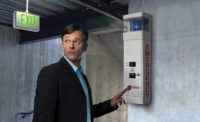How do you define the difference between emergency communication and mass notification? It turns out the difference is not so cut and dried. Some experts say the difference is in how messages are communicated — mass notification employs newer methods such as SMS, apps or even social media. Others feel it is more about the direction of the communication; while some say there is no difference at all. However, all the definitions share a common theme: some form of communication between people or systems that know something and the people that need to be informed.
“Emergency communications and mass notification are one and the same and regulated as mass notification systems (MNS),” says Jeff Spille, application engineering – fire alarm, STANLEY Convergent Security Solutions Inc., Fishers, Ind. “A mass notification system is defined as a system that can use intelligent voice communications, visible signals, signage, graphics, tactile or other communication methods. The system can be used to initiate evacuation or relocation or to provide information to occupants.”
7 Elements of an Effective EC/MNS
For security integrators looking to offer emergency communications and/or mass notification systems to their customers, the experts offer some advice for the top design and feature elements that make for an effective system.
- Intelligibility. Communication is only as good as it is understandable and audible, says Jon Hughes of Edwards. Zenitel’s Peter Sandin adds, “Intelligibility is the ability to hear, be heard and be understood. Every integrator and end user should benchmark this before purchasing and deploying this essential element.”
- Reliability. This includes both redundancy and a variety of communication methods to make sure it reaches as much of the intended audience as possible. There is no perfect 10, says Sam Shanes of Talkaphone. “But you ideally want to get to five 9s — 9.9999 percent. You want to get as close as you can to everybody because every life matters. You are going to need various technologies to do that.”
- Simplicity. In order to get to five 9s, communication has to be as simple as possible — ideally one action to take, Shanes adds. “It is up to the guy whose job it is to send out the alert. People’s lives depend on them doing it right so you have to make that task as simple and integrated as possible so it will get done right and not take too long. They can’t be looking at a manual.”
- Familiarity. In addition to being easy to use, a good solution should be part of the daily fabric of the users, says Karen Evans, CEO, Sielox LLC, Runnemede, N.J. “A configurable solution that is easy to use for both emergency events and daily incidents such as a disturbance or medical issue increases the user confidence through repetition. Kastle’s Bob Cutting agrees. “The daily use aspect of mass communications features builds end user usage, which directly builds adoption/enrollment into the EMC aspect of the app.”
- Layerability. Marla Reynoso, Eaton, stresses the importance of using different methods of communication. “According to NFPA, relying on just one method in an emergency could result in a relatively large portion of the targeted population not receiving the message. The overall solution is to deploy layer one and two elements such as an in-building mass notification system and an outdoor giant voice system, as well as layer three and four systems such as text messaging and social media that combine to produce a reliable and robust design.”
- Openness and Scalability. Honeywell’s Bruce Montgomery says a good mass notification system needs to be open, smart and tailorable. “Being open means the system can work with others at a lower cost; being smart means the system can adopt the latest analytical technologies to improve efficiency; and being tailorable means the system doesn’t impose limitations on whatever processes the end users want to use for notification.” Scalability is equally important says Aiphone’s Paul Hefty. “By using networkable equipment with open standards, it’s easier to replace a single component should it fail…. It also enables backwards/forwards compatibility and more easily scalable systems as users’ needs change.”
- Code Compliancy. While emergency communication and mass notification continue to expand in both definitions and offerings they are still at heart a life safety issue and as such are regulated by NFPA 72, says Jeff Spille of STANLEY Convergent Security Solutions. “A MNS is a complete 100 percent installation or nothing. MNS systems are life safety systems. They must meet code requirements and a design should be performed by a certified individual or designer…. There is no room for error.”
Jon Hughes, director of marketing and product management for Edwards, Bradenton, Fla., says the difference between the two is in how they are regulated. “Emergency communication is the process of one-way or two-way communication in an emergency between affected parties,” he describes. “As outlined by the National Fire Alarm and Signaling Code, NFPA72 Chapter 24, there are various categories of emergency communication systems to fit the target use cases of these systems.
“Mass notification is a method of emergency communication in the form of one-way communication to the affected parties. It is an essential function of a fire safety system. Therefore, the characteristics of MNS are defined and standardized with certain regulatory requirements from agencies including NFPA and UL to ensure they function in the most efficient and effective way during an emergency.”
Samuel Shanes, president and CEO, Talkaphone, Niles, Ill., uses a wheel analogy — with a hub, spokes and a rim. At the core is the hub, which is the security or emergency department or police. The spokes are the methods of communication, and at the rim is the public. “Emergency communication is, ‘I am a person at an end point and I am either experiencing or seeing an emergency and I need to provide information to the security professional at the core,’” Shanes explains. “Mass notification is the security professional who knows something you don’t and they have to communicate with everybody at the edge about a situation that will affect some or all of them.”
However you define it, a lot has changed in both the technology and implementation, as well as how security integrators can help their end-user customers get the best system for their needs.
Like much of the technological world, networking and integration have had huge impacts on emergency communication (EC) and mass notification systems (MNS); but some of the newest technology advancements can bring even more value to the table.
Many industry experts point to increasing integration — whether that is with other security systems or with different forms of emergency communication —as a big reason emergency communication is being discussed a lot right now.
For example, Zenitel, Kansas City, Mo., recently formed an intelligent partner network with LenelS2 and Milestone, among others, to work together for both integrations as well as new developments such as machine learning, says Peter Sandin, vice president of sales for Zenitel North America. “One of the most important developments in creating interoperable intelligent communications is collaborating in the development of emerging capabilities with the leaders in the industry,” he adds.
“The latest industry trend is to promote interoperability across all different systems via common or open protocols,” says Bruce Montgomery, business development manager, Honeywell Commercial Security, Melville, N.Y. “This can mean automated and dynamic guidance, whether by AI or geolocation. When we looked at our mass notification, we really looked at not just alarms but how do we interact with Amber alerts or social media? These are the latest trends that are, in our opinion, some of the more valuable that we see.”
Some examples he points to are integration with LED signage, and two-way messaging using text messages. Honeywell’s latest offering is the UNP Unified Notification Platform, a mass notification platform introduced in 2018 that delivers two-way notifications and allows the end users — whether they are teachers in a school or workers in an office — to send outgoing texts about their location and whether they are OK, as well as receive updates and instructions from authorities, Montgomery explains. “We looked at this with a broad brush and said, ‘How can we best serve potential victims in many situations with so many variables?’”
The Up & Downsides of Apps for Emergency Communication
While smartphones have proliferated and are even a preferred method of communication in many instances, some experts caution against making them the primary method of emergency communication or mass notification; while others embrace the mobile-first movement.
“I’m not opposed to apps and have partners who do them and we have some,” says Talkaphone’s Sam Shanes. The problem, he says, is the buy-in and how many do or don’t sign up for the service. “Currently the records aren’t so good. If you take college campuses, for example, students don’t sign up for them [in large numbers].”
Another issue, Shanes says, is visitors or others not native to the location. “What are the chances they downloaded the app? What is the chance they are going to have it when they need it?”
Apps have their place but should be only a part of an overall solution that includes emergency towers, speakers and other means of communication, Shanes notes. “Can they be useful? Yes. Would you bet your life on it?”
Integrator Kastle Systems, however, takes the approach that mobile-first is the way of the future and should be used more often in emergency communication. “We have a ready and willing audience with eyes and ears and little smartphone devices in their back pockets or purses, says Bob Cutting. “Why are we so timid to leverage that and allow anyone to report something immediately to all, or at least to a person in charge?”
To help alleviate the enrollment issue, Kastle’s EMC solution ties directly into its existing mobile access control platform and enrolled subscribers are automatically added to the emergency offering, Cutting explains.
Rave Mobile Safety is another mobile solution that is working to make it simpler and more widespread to use, even without apps, says Katharine Dahl, director of product marketing at Rave, Framingham, Mass. “Through Rave’s geo-poll features employers can collect poll responses with the real-time location of employees without the use of an app.
“For visitors and temporary workers, employers can provide a simple text to opt-in solution. Temporary visitors can text a keyword to join the emergency notification list to receive real-time notifications during an emergency,” she says.
Smartphones have an increasingly bigger role to play in emergency communications and mass notification. Integrator Kastle Systems, Falls Church, Va., recently adopted a mobile-first approach to emergency messaging, says Bob Cutting, head of product at Kastle. “The three trends we preach to the market are mobile, crowdsourced and connected. Mobile may not be a ‘latest’ trend for you and me, but the adoption of mobile for EMC is not nearly as far along as you might think.” (For more on the pros and cons of mobile use for mass notification see the sidebar on page 62.)
Kastle refers to this as “the new normal,” marking a change from the fire-first approach. “Regarding the ‘old,’ companies built emergency notifications around the fire or occasionally hurricane and the rare bomb scare/suspicious package,” Cutting says. “The new normal addresses what we experience today. Technology is a two-way street.”
Two-way communication is the latest trend in mass notification, adds Kevin McCarthy, national sales manager EMERgency24, Des Plaines, Ill. “With the ability to both send and receive information to and from impacted people, first responders and incident commanders can better plan their response efforts to mitigate the impact of a severe situation.”
EMERgency24 uses a secure, Web-based portal that allows incident commanders to send and receive information to and from building occupants by text or email during emergencies, McCarthy explains. It also adds AI to the mix, he says. “All of those responses from building occupants are examined by algorithms to identify and flag common terms. This is extremely valuable when you are dealing with large numbers of people responding to the notification message.” It also uses GPS tracking to allow users to check-in as safe during or after an event.
Perhaps the greatest advantage of the newer types of services is they allow dealers and integrators to generate RMR by selling access to a portal or messaging service, McCarthy says. “Integrators can also sell mass notification services to communities, which is a huge new segment of potential customers. Those communities in turn would promote a website or text address that enables citizens to opt in to receive local alerts.”
Increasingly, customers — from cities to schools to companies — are looking for these types of solutions, particularly as tragic events, violent storms and other threats make the front page of news. “As our global weather patterns change and the ease with which news spreads, the average person’s awareness of critical, life-impacting events grows dramatically,” says Chris Holbert, CEO of SecuraTrac, Hermosa Beach, Calif. “This ‘from the customer up’ effect drives demand for more real-time information on how people can protect themselves as well as friends, family and coworkers.”
Paul Hefty, technical sales and support engineer II, Aiphone Corp., Redmond, Wash., agrees. “News about emergencies, either manmade or weather, reminds us that these types of events can happen anywhere. The National Weather Service routinely broadcasts weather updates. Organizations are now tying NWS’ emergency broadcasts into their mass notification systems to help keep people informed,” he says.
The proliferation of smartphones has really helped drive this demand, says James Hoang, partnering and integration manager, Speco Technologies, Amityville, N.Y. “According to Pew Research, 95 percent of all Americans own some form of mobile device that can receive text messages. With this fact, Speco is leading the charge to inform our network of dealers and integrators that they need to educate their clients on the need to add mass notification capability to their video system. People want peace of mind that they will never be out of touch because they will be informed through their mobile devices. Speco’s mass notification system offers integrators a way to make RMR with choices in notification plans that are appropriate for their clients’ sites.”
While mass notification has traditionally been tied to the fire system — and defined by the National Fire Alarm and Signaling Code — these are just a few examples of how this technology transcends the code-driven market and is a matter of customer desire rather than a reluctant must-do for the fire inspector.
The key, says Marla Reynoso, commercialization and product marketing manager, Eaton, Long Branch, N.J., is to find ways to get beyond the noise in today’s information-overload age. “From TV to podcasts and from text messaging to social media there has been an exponential increase in the number of communication channels in which we receive information. This overload can not only prevent people from listening to or reading emergency messages, but also from taking the appropriate actions to reduce risk.”
More Online
For more on emergency communication and mass notification systems visit SDM’s website, where you will find the following articles:
“State of the Market: Fire Alarms 2018”
www.SDMmag.com/state-of-the-market-fire-alarms-2018
Mobile and Integrations Drive Today’s Mass Notification Systems
www.SDMmag.com/mobile-and-integrations-drive-mass-notification-systems
Mass Notification Has More Choices Than Ever Before












